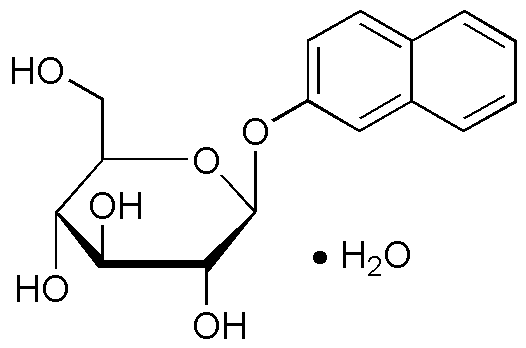2-Naphthyl b-D-glucopyranoside monohydrate is widely utilized in research focused on:
- Biochemical Research: This compound serves as a substrate in enzyme assays, particularly for studying glycosidases. Researchers can measure enzyme activity and kinetics, aiding in the understanding of carbohydrate metabolism.
- Pharmaceutical Development: It is used in drug formulation studies to assess the bioavailability of glycoside compounds, helping to optimize therapeutic agents derived from natural products.
- Food Industry: The compound can be employed in flavor and fragrance studies, as it can mimic certain natural flavors, providing insights into product development and sensory analysis.
- Plant Biology: It is utilized to investigate plant glycosylation processes, allowing scientists to explore how plants modify compounds for storage and transport, which is crucial for agricultural research.
- Analytical Chemistry: The compound is valuable in chromatographic methods for separating and identifying glycosides in complex mixtures, enhancing the accuracy of chemical analysis in various samples.
General Information
Properties
Safety and Regulations
Applications
2-Naphthyl b-D-glucopyranoside monohydrate is widely utilized in research focused on:
- Biochemical Research: This compound serves as a substrate in enzyme assays, particularly for studying glycosidases. Researchers can measure enzyme activity and kinetics, aiding in the understanding of carbohydrate metabolism.
- Pharmaceutical Development: It is used in drug formulation studies to assess the bioavailability of glycoside compounds, helping to optimize therapeutic agents derived from natural products.
- Food Industry: The compound can be employed in flavor and fragrance studies, as it can mimic certain natural flavors, providing insights into product development and sensory analysis.
- Plant Biology: It is utilized to investigate plant glycosylation processes, allowing scientists to explore how plants modify compounds for storage and transport, which is crucial for agricultural research.
- Analytical Chemistry: The compound is valuable in chromatographic methods for separating and identifying glycosides in complex mixtures, enhancing the accuracy of chemical analysis in various samples.
Documents
Safety Data Sheets (SDS)
The SDS provides comprehensive safety information on handling, storage, and disposal of the product.
Product Specification (PS)
The PS provides a comprehensive breakdown of the product’s properties, including chemical composition, physical state, purity, and storage requirements. It also details acceptable quality ranges and the product's intended applications.
Certificates of Analysis (COA)
Search for Certificates of Analysis (COA) by entering the products Lot Number. Lot and Batch Numbers can be found on a product’s label following the words ‘Lot’ or ‘Batch’.
Numéro de catalogue
Numéro de lot/série
Certificates Of Origin (COO)
This COO confirms the country where the product was manufactured, and also details the materials and components used in it and whether it is derived from natural, synthetic, or other specific sources. This certificate may be required for customs, trade, and regulatory compliance.
Numéro de catalogue
Numéro de lot/série
Safety Data Sheets (SDS)
The SDS provides comprehensive safety information on handling, storage, and disposal of the product.
DownloadProduct Specification (PS)
The PS provides a comprehensive breakdown of the product’s properties, including chemical composition, physical state, purity, and storage requirements. It also details acceptable quality ranges and the product's intended applications.
DownloadCertificates of Analysis (COA)
Search for Certificates of Analysis (COA) by entering the products Lot Number. Lot and Batch Numbers can be found on a product’s label following the words ‘Lot’ or ‘Batch’.
Numéro de catalogue
Numéro de lot/série
Certificates Of Origin (COO)
This COO confirms the country where the product was manufactured, and also details the materials and components used in it and whether it is derived from natural, synthetic, or other specific sources. This certificate may be required for customs, trade, and regulatory compliance.


